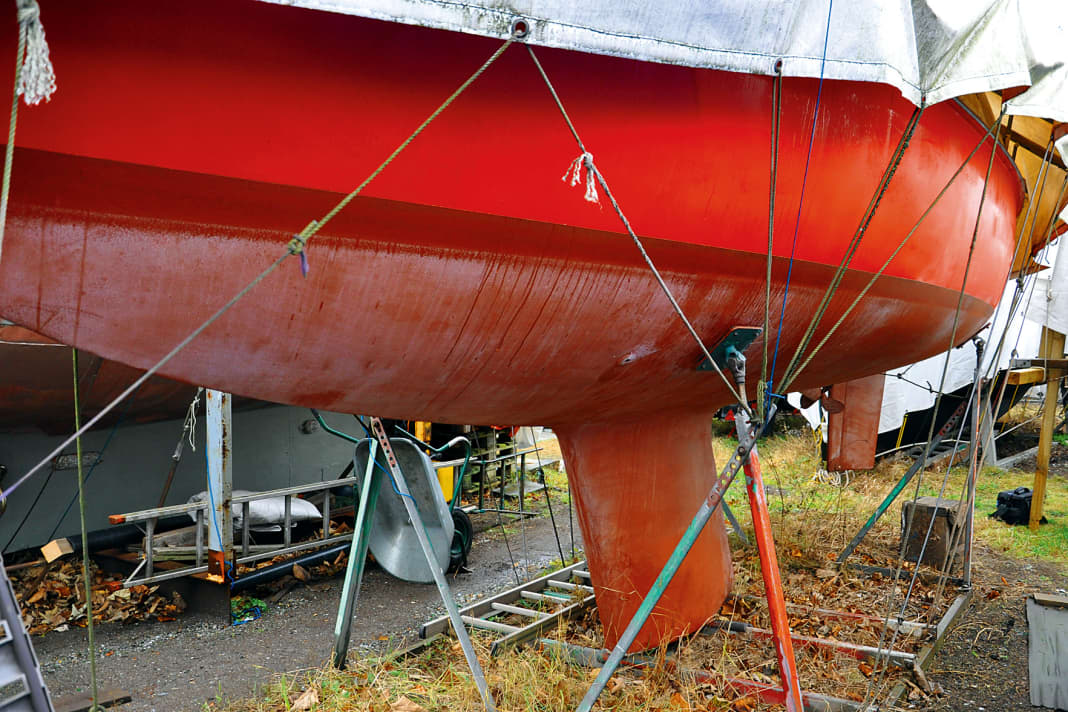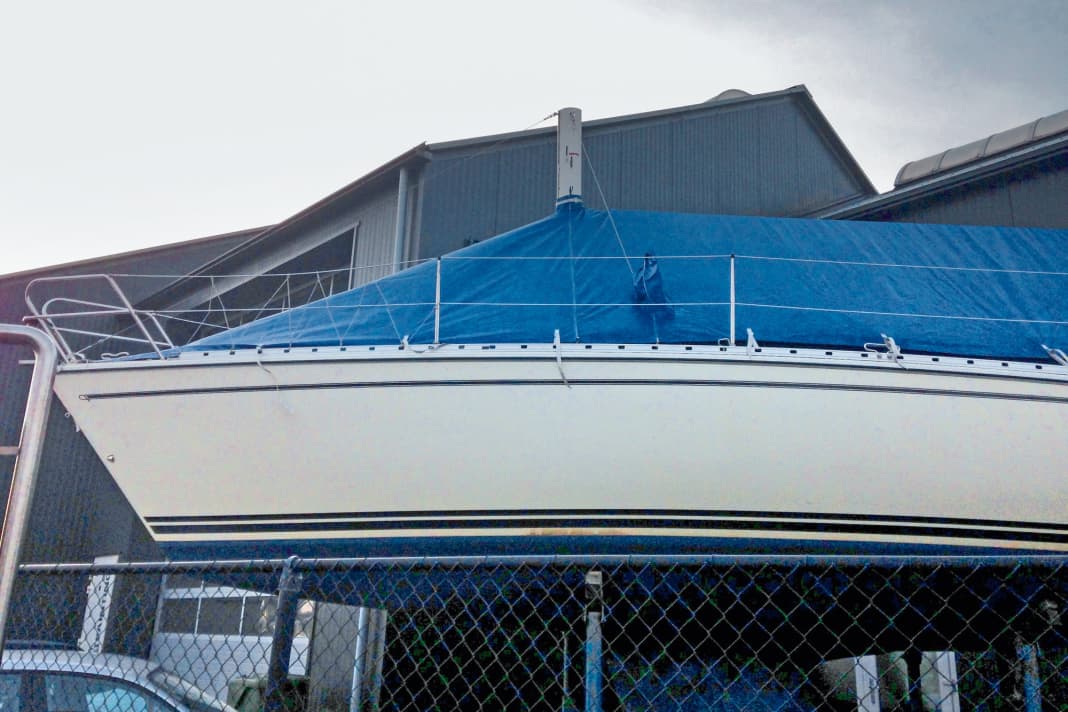Winterising outdoors: Outdoor winter storage - what to watch out for, especially during storms






Leave the mast in winter storage or not?
One question that naturally does not arise during indoor storage is whether the mast can remain standing or not. What is generally frowned upon along the German coast is common practice in other countries. Around the Mediterranean, in Scandinavia or even in the Netherlands: The masts stay up everywhere - even if the boats spend the winter on land.
There are many reasons for leaving the asparagus standing: for example, the need to have a support for a winter tarpaulin in the form of the boom, the reduced effort involved in winterising and winterising, the risk involved in laying and erecting the mast and, of course, the cost. Apart from the question of whether the mast should be erected: Is it even okay to leave it up? Well, that's up to the operator of the winter storage facility. In this country, many require the mast to be laid down, in which case the owner simply has no choice.
"We can do both. If you want to leave the mast standing, you can. However, we are also quite sheltered from the wind with our outdoor area. And we always try to use trestles with large supports rather than those with wedges. This protects the structure," Thedje Ancker from Kappeln told YACHT back in 2021. They also endeavour to place the supports in the area of stringers or bulkheads so that the resulting forces are better absorbed.
Liability or comprehensive cover: What does the insurance cover?
Another question is that of insurance. The owner should clarify with them whether storage with the mast upright is included. Hull damage, i.e. damage to your own boat, is one thing. But what happens if the mast of another boat falls on your own boat and causes damage? "Yachts have liability according to the principle of fault-based liability. The injured party must prove who is at fault for the damage. The owner of the unmasted boat and the winter storage operator are quick to point fingers at each other. If no fault can be established, the injured party is left with the loss," reports Dirk Hilcken from the insurance broker Pantaenius. "If the mast comes down in a storm, it's force majeure. In that case, no liability insurance will pay out anyway, so you have to take out your own comprehensive insurance - with an excess and a higher premium that the injured party has to pay afterwards."
If you decide to winterise your boat with the mast up, either because it is customary in your home waters or for other reasons, and if this is covered by your own hull insurance, what do you need to bear in mind?
Movement in the rig increases wear
"Vibrations in the rig should be avoided as far as possible," says Sören Matthiessen from Gotthardt in Hamburg. He is the rigging specialist at the Seldén importer for Germany. "For example, you can lead the topsail halyard around the front of the empty furling jib and attach it to the foot of the mast. Then the forestay can no longer slap so much. Because movement always means wear and tear. That's obviously not good," says the expert.
He also refers to the Seldén rigging guide. It states that the shrouds can be easily loosened without being loose when the mast is upright in winter storage. However, the stays must remain tight. This means a continuous load for the ship's structure. Furthermore, pilot lines can be used instead of halyards to prevent them from snagging or wearing out due to excessive movement.
"Apart from that, there's not much you can do. The best thing, of course, is to lay the mast. That way, the tensioners are also moved, so they don't seize up so quickly. And you can carry out a visual inspection of the mast. You don't get to do that otherwise." In particular, check the T-terminals, their retaining plates and the terminals. "The top of the rolling system is always a particularly critical place to check. Are the card wires coming loose or is the wire twisting? And another request: Don't use ring cotter pins. Plug-in cotter pins are simply safer."
Sails must be taken down in winter
Incidentally, it is not advisable to secure the rig with a halyard to a fixed point on the ground. The hull and mast must be able to move together so as not to increase the loads on the rig caused by the wind pressure. This movement is of course only minimal on the trestle, in the water the boat could simply heel away in gusts and thus reduce the load, but even small movements of the hull at a height of many metres can mean an enormous distance. However, if the mast is tensioned in such a way that it cannot move, additional loads are created.
By the way: It is obligatory to remove the sails. A furling jib increases the wind load enormously. However, a furling mainsail that has disappeared into the mast must also be removed. Its weight increases the top load and thus the loads.
Important: the right trestle for the ship






But securing the rig is only one aspect of outdoor storage. Of course, the boat must be winterised as usual. The seacocks, drinking water system, toilet and engine need attention. The upholstery and batteries too; neither of these belong on board in winter, just like the gas bottle. Special attention should be paid to the trestle on which the boat stands. Is it big enough? Does it fit the hull? Are the supports far enough apart? Are they stable enough?
Thedje Ancker describes: "The wide ships with deep but short keels are quite a challenge. Due to the width, the supports are positioned far inboard. The support on the keel is only short, so there is little support. The loads on the patches are then enormous. And the further inboard the supports are, the higher the risk of the ship tipping off the trestle. We therefore work with special trestles, which we support additionally if necessary. For long ships, additional bracing timbers are added at the front and especially at the stern. Then the ship is stable."
The trestle must stand well and securely
Supports that extend particularly far are lashed together with tension belts so that they cannot bend outwards. Another problem is the frequent lack of structure in the stern of the boats. "That's where the bunks are, often with tanks underneath. There are no bulkheads that can be used specifically to provide support there," continues Ancker. Many winter storage operators try to position the ships with the bow facing the main wind direction, which is usually south-west. Logically, the trestle and ship are more stable lengthways. It's just a shame if the storm doesn't stick to this and it blows from the north-west. Then the pressure comes from the side.
The boats are often secured to the trestle with lashing straps to prevent them from tipping over. It is also good if the trestle itself stands on solid ground and cannot slowly but surely work its way into the soaked ground at one corner during persistent rain and storms - then there is a risk of tipping. Some winter storage operators also secure the trestles of outside vessels with straps to lashing eyes in the floor. This prevents a domino effect and increases the stability of all boats.
The right tarpaulin for winter storage






In outdoor storage, the ship must be protected from the weather but also well ventilated. This requires an effective opening at the front and rear of the tarpaulin. In this way, some air constantly passes underneath and condensation is avoided.
Thedje Ancker: "Please don't use one of those rags from the DIY store. They never hold properly, start to flap and then cause strong vibrations all over the ship. That's very unfavourable." What's more, they are usually just a pile of plastic rubbish after one winter.
Correct tensioning of the cover is also important: "We've already had cases where the weights on the tarpaulin have cheerfully maltreated the freshly painted neighbouring ship in a storm. That's unpleasant, of course," reports Dirk Hilcken. Ancker points out that the wedges on which the ship rests are not a good point for securing the tarpaulin. "If it flutters, the wedges will fly out at some point. Then the ship tips over. That is grossly negligent." Well braced to the trestle or the hull, that's fine. "It's best to have a tarpaulin from the sailmaker that fits exactly. Nothing flutters, no water pockets form, and the loads on the boom, the dirk and the railing supports are not so high," says Ancker.
Outdoor winter storage has many advantages
Storage outside a hall, regardless of whether the mast is on board or on deck or in the mast store, certainly has advantages. Many jobs that are perfectly possible outside are often prohibited in halls. Sanding, for example. This is often possible after consultation with the operator. Make sure that regulations such as covering the floor and good extraction are observed. And in spring it is often warmer outside than indoors, so it is easier to paint and polish. If the boat spends the winter in outdoor storage, it may make sense to polish it in the spring. If the tarpaulin has left scuff marks on the hull, they can be removed in this step.
The experts agree that outdoor storage is not a problem if winterised correctly. There is also unanimous agreement that it is better not to leave the mast standing. However, there is no evidence that ships that spend the winter ashore with the rigging upright are more likely to lose their masts. And: even in a hall, the ship is not always safe.

